Summary
Reproduction made in 2006 of the Eight Hour Day banner first carried by unionists in a march on 12 May 1856 from Carlton Gardens to Cremorne Gardens in Richmond, where a fete was held to celebrate the gain of the eight hour day.
This reproduction banner was made as part of the celebrations of the 150th anniversary of the Eight Hour Day in 2006. It was displayed at the exhibition held at the Ian Potter Museum of Art, University of Melbourne, 'Under the Burning Sun of the Colony: The Eight Hour Movement', 17 June to 17 September 2006. A second reproduction banner was used in community events during the anniversary and donated to the Victorian Trades Hall Council.
Planning for the celebrations to mark the 150th anniversary commenced in mid-2003. The main program partners were Australian Centre for the Moving Image, Australian Society for the Study of Labor History, City of Melbourne, Heritage Victoria, Melbourne Workers Theatre, Museum Victoria, RMIT University, State Library of Victoria, University of Melbourne and Victorian Trades Hall Council. The final line-up for the program included 11 exhibitions, three theatrical shows, two conferences, a public forum, public lecture, two community events and a banquet.
Physical Description
Blue cotton with red cotton border and appliqué canvas letters; reinforced eyelets. Appliqué text reads: '8 Hours Labour, 8 Hours Recreation, 8 Hours Rest'.
Significance
Following the attainment of the eight hour working day for the building industry from 21 April 1856, workers established an Eight Hours League to work for its extension to other trades. They also organised a procession and fete for 12 May 1856, to celebrate their achievements. Thomas Vine, president of the League, commissioned his daughters Caroline, Elizabeth and Isabella and his wife to make a banner. Thomas sketched the design and Caroline purchased the thread and bunting from Buckley & Nunn. The banner, 17 feet 2 inches long and 9 feet high, was carried on the procession from Carlton Gardens to Cremorne Gardens in Richmond. The banner was subsequently used at the front of the procession for the Eight Hour Day celebrations each year, until around the First World War. The banner then reportedly disintegrated in a shed behind a house in Coburg.
This reproduction banner was made as part of the celebrations of the 150th anniversary of the Eight Hour Day in 2006. It was displayed at the exhibition held at the Ian Potter Museum of Art, University of Melbourne, 'Under the Burning Sun of the Colony: The Eight Hour Movement', 17 June to 17 September 2006. A second reproduction banner was made and donated to the Victorian Trades Hall Council.
More Information
-
Collection Names
-
Collecting Areas
-
Acquisition Information
Commission & Subsequent Transfer from Melbourne Museum, Museum Victoria, MHW Design, Sep 2006
-
User
Victorian Trades Hall Council (VTHC), cnr Lygon & Victoria Streets, Carlton, Greater Melbourne, Victoria, Australia, 2006
-
Inscriptions
Appliqué text, front: '8 Hours Labour, 8 Hours Recreation, 8 Hours Rest'. Handwritten on reverse, black pen: "MARK WAGER & James Clyne 06.04.06"
-
Classification
-
Category
-
Discipline
-
Type of item
-
Overall Dimensions
5320 mm (Length), 3540 mm (Height)
-
References
Recorder (Australian Society for the Study of Labour History, Melbourne Branch), no 151, May 1988 W. E. Murphy, History of the Eight Hours' Movement, Melbourne, 1896
-
Keywords
8 Hours Day Movement, Trade Unions, 8 Hours Day Celebrations, Workers Rights, Working Life, Workers, Making History - Eight Hour Day
